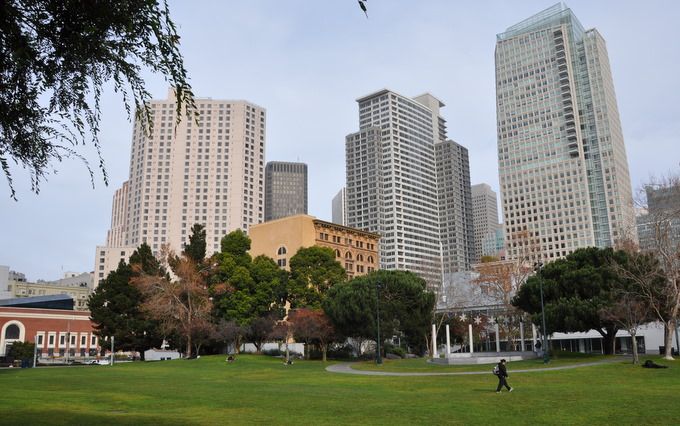The Berkshires Bowling Alley that Inspired "The Big Lebowski"
It’s been 36 years since the release of The Big Lebowski, the irreverent cult comedy by Joel and Ethan



Yerba Buena Gardens is a two-block public park that anchors the three sides of the Yerba Buena Center (YBC). The area got its name in 1835 for the “good herb” -mint-growing in the area.
YBC is officially in the South of Market Area (SOMA). Jack London first called this area “south of the slot,” in reference to the cable-car tracks that ran down the center of Market Street.
In 1847 when the city fathers laid out the SOMA, it was partitioned into lots twice the size of those in the north of market area. SOMA also had easy access to the piers, making it a likely location for industrial development. Businesses that eventually settled in the area included factories, gas works, machine shops and laundries. After the 1906 earthquake and fire wiped out the area, reconstruction of SOMA was hasty, resulting in residential hotels, boarding houses, flats and the occasional single-family dwelling.

The 1950s brought a groundswell among business leaders-especially real estate developers-for urban renewal. In 1953 the San Francisco Board of Supervisors designated twelve “blighted” blocks as a redevelopment district. The controversial head of the San Francisco Redevelopment Agency, Justin Herman, led the charge, commenting that “The South of Market Area ranks among the most severely blighted sections of the city”¦[T]he conditions of the blight are such as to be highly conducive to social disintegration, juvenile delinquency, and crime. The present wasteful use of potentially valuable land must be stopped.” The proposed redevelopment plans included theaters, restaurants, office spaces, hotels, a convention center and a sports complex-all intended to comprise the Yerba Buena Center.

The November 3, 1965 Official Bulletin of the San Francisco Labor Council ran an article by their secretary-treasurer, George John. He wrote, “Speculative real estate operators”¦seem to have taken over the planning functions of our city”¦.Convention halls and sports arenas have their place. But the loss of millions of square feet of industrial space can only extend unemployment, suffering and poverty”¦.A redevelopment program is certainly needed there. However”¦a rehabilitation and conservation program makes for better sense than the program of massive clearance”¦”
 Ohlone Indian Memorial: Oche Wat Te Ou
Ohlone Indian Memorial: Oche Wat Te Ou
Despite opposition efforts, official removal of SOMA residents began in 1967. By 1969 the Redevelopment Agency had acquired 44% of the properties required for the project. Buildings began to sink into states of disrepair, and the neighborhood continued to decline.
This situation brought out the fight in 80-year-old George Woolf. A retired union man, he was perfect to head up the Tenants and Owners in Opposition Group (TOOR) formed by the residents of the Milner Hotel. Their biggest concern was the displacement of the elderly: 33% of the residents of the area were men over the age of 60, and the average income in the area was $2734, only one quarter of the average income across the city.

In response to Justin Herman’s statement that the folks of SOMA were “nothing but a bunch of skid row bums,” Woolf responded, “I’m not a bum, and I resent being discredited and discounted.”
In an ironic twist, some of the strongest supporters of the YBC were the Building and Construction Trades Council, as well as the Bartenders and Culinary Workers and Cooks Union; they all saw the redevelopment as an opportunity for more jobs. While it was pointed out that most of the men being evicted were on union pensions, one union representative was reported to have said, “They poor-mouth a lot, but under our system the residents can’t remain. A few can’t hold up progress.”
TOOR and their lawyers were able to bring an injunction against the San Francisco Housing Authority in 1970, and construction was stopped. The two sides agreed to bring in an outside party to help with the negotiation process. Their choice, former California Governor Pat Brown, recommended that the project should include 2000 low-income housing units. The judge ruling in the case lowered this number to between 1500 and 1800, and the San Francisco Housing Authority found a way to circumvent the priority list, limiting the number of original SOMA residents to receive this housing.
 Cho En Butterfly Garden
Cho En Butterfly Garden
Delayed for several more years by additional lawsuits, construction did not recommence until the 1980s, and designs for the sports complex were eliminated.
The first portion of the Yerba Buena Center to be built was Moscone Center South. It was completed in 1981, and the Democratic Convention was held there in 1984. The second portion was Moscone North, completed in 1992, the Yerba Buena Gardens along with the Yerba Buena Center for the arts followed in 1994.
Now YBC is a tranquil San Francisco spot, perfect for tai-chi, dog walking and people watching. Few people making use of the lawn built atop the underground Moscone Center ever know about the long, contentious history of this serene garden oasis.
Follow Untapped Cities on Twitter and Facebook. Get in touch with the author @PQPP3.
Subscribe to our newsletter